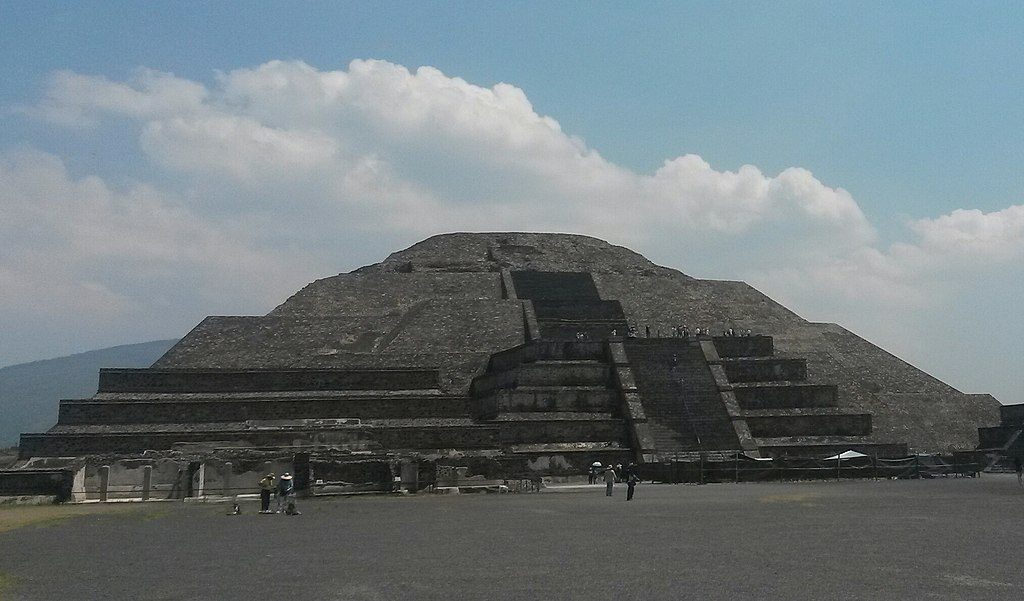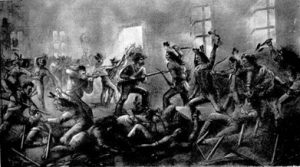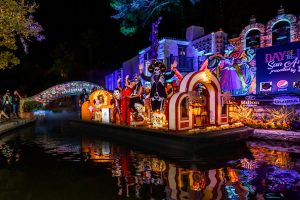At the heart of the mighty Aztec empire laid the capital Tenochtitlan, the Venice of the new world. No other civilization at the time could hope to compare to the city’s impressive pyramids, glamorous temples, and advanced aqueducts. At one point in history, Tenochtitlan was so populous that it contained around 200,000 inhabitants. But Tenochtitlan wasn’t always such a powerful urban site. When the Aztecs were immigrants looking for a new home, they were captivated by a mysterious ancient city. To this day, no one really knows who built it or what happened to its inhabitants. But to the Aztecs, they believed that out of this city emerged the whole of human society and order. This once glorious city was known as Teotihuacán.

There is only a minuscule amount of knowledge about Teotihuacán because a sufficient written record of the city does not exist. In fact, no one knows what the people of Teotihuacán called themselves or what the actual name of the city was. Indeed, it wasn’t until much later that the Aztecs named it Teotihuacán, which means “city of the gods.”1 To an extent, the Aztecs were not exaggerating, because Teotihuacán was once an electrifying center for religion, trade, and culture. At one point, the city contained over 2,000 apartment buildings, 600 pyramids, around 500 workshops, and countless temples, plazas, and palaces.2 But how, exactly, did Teotihuacán become such a powerful metropolis? Once again, let us look at what the Aztecs themselves have to say about it.
According to an Aztec legend, the world was created and destroyed four times before the creation of our current world. Each time the world was destroyed, the sun quickly perished alongside it, and a new sun, presided by a god, was required to create another world.3 The first world was under the dominion of Tezcatlipoca–the god of the night. During his era as the sun, there were no humans, but rather a race of vegetarian giants that roamed the Earth. Tezcatlipoca’s reign lasted for 676 years, but it was cut short when Quetzalcoatl, the god of the wind, grew displeased as he saw the other deity ruling above the land. So he used his staff to knock down Tezcatlipoca into the seas at the farthest corners of the earth. Angered by this, Tezcatlipoca gathered his strength and emerged from the water as a powerful jaguar, running through the Mesoamerican plains and mountains. Soon, many jaguars appeared alongside him, and they eventually hunted and killed every giant on Earth–thus bringing an end to the first world.4
Quetzalcoatl then presided over the second world and, under his rule, human-like beings began to appear. His reign was only 364 years long, however, for Tezcatlipoca wanted revenge on his cosmic rival. Using his dark powers to overwhelm the wind god, he launched a massive hurricane that swept away the sun and the people. Darkness then covered the world and the survivors hid in the trees, eventually turning into monkeys.5

Tlaloc, the rain god, found opportunity in the darkness, and quickly took charge over the new third world. Much to Tlaloc’s dismay, Quetzalcoatl was displeased with his rule, and he sent a rain of fire that again destroyed the sun and earth. The survivors who hid from the fire became the ancestors of the dogs, turkeys, and butterflies of today. The goddess of the lakes and oceans, known as Chalchiúhtlicue, then presided over the fourth sun and world. Although her reign lasted much longer than the previous two, tragedy was no stranger to the gods. Although no one knows exactly how the fourth world ended, Aztec accounts seem to tell the story of a great flood covering the Earth, turning the inhabitants of that world into fish, whales, and other creatures of the deep ocean.6
After some time, all the gods gathered at Teotihuacán. The earth was filled with darkness and a new sun was needed. The gods also decided that a moon should provide light when the sun did not. The rich god Tecuciztécatl proudly stepped forth to be the new sun. But a small, humbler god, Nanahuatzin also volunteered. After agreeing to share the Earth, the two made preparations to renew the world.7 For four days, Tecuciztécatl and Nanahuatzin prayed and fasted.8 When they finished, the other gods lit a great fire on the hard earth of Teotihuacán. In his lavish robes, Tecuciztécatl threw valuable quetzal feathers, stone flints, and incense into the fire as sacrifices. Nanahuatzin, having no riches to sacrifice, humbly offered weeds drenched in his own blood. The two slowly then approached the menacing flames of the fire. Tecuciztécatl intended to go first but he was ultimately driven back by the heat of the inferno. He approached it again for the second time… the third… the fourth. No matter what he did, the rich god was being held back by his fear. Then Nanahuatzin stepped forward. With his eyes closed and mind stilled, Nanahuatzin leapt into the great fire. Having been awestruck by his rival, Tecuciztécatl quickly rushed into the flames. Nanahuatzin then became the new sun, while Tecuciztécatl became the moon.9

The gods then waited for the new world to develop. However, after a while, the gods noticed that nothing was happening. Why wasn’t the new sun in motion? Why hadn’t the world been fully restored? After a discussion with Nanahuatzin, the rest of the gods then threw themselves into the fire, one by one, to restart the world. After all the gods sacrificed themselves, the age of the fifth sun began, and the world was now in motion. It was then, that out of Teotihuacán human society was born. The city flourished under the leaders and priests of Teotihuacán and it is said that after their deaths the pyramids of the sun and moon were built by giants.10
Though we may never know how this city actually came to be, it is no mystery that Teotihuacán was once a revered city in Mesoamerica. To this day, many visit the ruins of Teotihuacán and observe its sites, such as the “Avenue of the Dead,” a two-mile road that connects the Pyramid of the Moon to a large market. Other wonders include the towering Pyramid of the Sun, which was once a revered ritual site because it was built over a cave that many once believed was the place where humans emerged into the world.11 Some of the palaces and temples still stand today, such as the famed temple of Quetzalcoatl. While Teotihuacán may have a murky history, its name continues to stand against the sands of time, eternally offering its mysterious beauty to curious observers everywhere who yearn to learn more of humanity’s past.
- Early Civilizations in the Americas Reference Library, 2005, s.v. “Teotihuacán,” by Sonia G. Benson. ↵
- Charles Phillips, Aztec and Maya: The Complete Illustrated History: The Greatest Civilizations of Ancient Central America with 1000 Photographs, Paintings and Maps (New York: Metro Books, 2008), 55. ↵
- Early Civilizations in the Americas Reference Library, 2005, s.v. “Teotihuacán,” by Sonia G. Benson. ↵
- Charles Phillips, Aztec and Maya: The Complete Illustrated History: The Greatest Civilizations of Ancient Central America with 1000 Photographs, Paintings and Maps (New York: Metro Books, 2008), 160. ↵
- Charles Phillips, Aztec and Maya: The Complete Illustrated History: The Greatest Civilizations of Ancient Central America with 1000 Photographs, Paintings and Maps (New York: Metro Books, 2008), 160. ↵
- Charles Phillips, Aztec and Maya: The Complete Illustrated History: The Greatest Civilizations of Ancient Central America with 1000 Photographs, Paintings and Maps (New York: Metro Books, 2008), 161. ↵
- Charles Phillips, Aztec and Maya: The Complete Illustrated History: The Greatest Civilizations of Ancient Central America with 1000 Photographs, Paintings and Maps (New York: Metro Books, 2008), 161. ↵
- Early Civilizations in the Americas Reference Library, 2005, s.v. “Teotihuacán,” by Sonia G. Benson. ↵
- Charles Phillips, Aztec and Maya: The Complete Illustrated History: The Greatest Civilizations of Ancient Central America with 1000 Photographs, Paintings and Maps (New York: Metro Books, 2008), 162. ↵
- Early Civilizations in the Americas Reference Library, 2005, s.v. “Teotihuacán,” by Sonia G. Benson. ↵
- World History Encyclopedia, 2011, s.v. “The Teotihuacan Empire, 300–650 CE,” by Alfred J. Andrea. ↵




102 comments
Antonio Coffee
I have always been fascinated by mythology but Aztec mythology is one that I never really had the opportunity to learn about. All of the books I found always focused on Egyptian, Roman, Greek, and Norse mythology. It was interesting to learn how the Aztecs believed in a cycle of death and rebirth which is closed to the ideas of Eastern cultures than Western ones. To hear this side of mythology was really nice as it has been extremely underrepresented in most mythological circles.
Leonardo Gallegos
I’ve visited this site before and it is absolutely beautiful but exhausting to walk all the way up the pyramid. I have always had an idea of the story of Teotihuacán but this article really provided a lot more insight than I knew initially. I did not know that there really is that there wasn’t much knowledge due to the there isn’t a written record of the city and the fact that it remains a mystery that no one knows what the people there called themselves or what they named the city. Great article!
Diego Terrazas
This civilization’s story of creation is one of the most unique ones I have read. It is quite evident how the Atecs revered and feared the sun. It is interesting how the rest of the gods had to sacrifice themselves to start the new world. It is insane how this place was a massive ancient metropolis. I wonder how much more we would have know if they were to have had a written language.
Mariah Garcia
This was an awesome article! The Aztec pantheon has always been an interesting topic for me, and to read about it here in an academic setting was really refreshing. The Aztec pantheon was always so fascinating in that they operated in a fashion similar to the Greco-Roman pantheon in the vein of the constant pettiness and sacrifices. It is interesting that the city of Teotihuacan also had pyramids, and seemed to have developed them independently while still resembling the pyramids of other distant cultures.
Fatima Navarro
Great article. Teotihuacan is so mysterious and its history is wonderful. I am Mexican and have always felt pride over the Aztec history. I liked the use of pictures as well, though I would’ve loved to see older pictures of Teotihuacan, not only recent ones. Also, maybe have some pictures of the inside, which is also beautiful. Nevertheless, I liked the flow of the story.
Joshua Garza
Its amazing and mysterious to think that such a mighty civilization existed and to not know its origin, history, or full belief system. It makes me wonder what ever happened to the people that came before the Aztecs. If they didnt build the city then that must mean that the people before them must have been much more mighty and triumphant to build such a city and leave it abandoned yet shine so gloriously.
Ruby Wynn
This is a great article. I did not know that the Aztecs believed that there were multiple worlds and that the sun was a different god for each world. I find how the Aztecs believe each type of animal comes from the destruction of each earth. I also like the story for the final sun and moon and how the smaller god has no problem sacrificing himself, and that inspires the other gods to fearlessly sacrifice themselves to restore the world.
Michael Hinojosa
I’ve never actually seen or heard of any mayan ruins before so it was no wonder why this article caught my attention so quickly! I’ve always been somewhat curious about these types of ancient civilizations so to read about something like an Aztec Capital was definitely a well appreciated history lesson; even if we still don’t know all the mysteries behind it!
Krystal Rodriguez
I have been to a mayan ruin before and seeing these amazing constructions done without the modern technology we have now is amazing. I imagine the aztec ruins are just as if not bigger than those i saw. The conplexity of their beliefs and creations is breath taking. Its sad we will never truly know the origin of this beautiful city.
Sydney Aleman
My most favorite part of the the article that I found interesting was, “After a discussion with Nanahuatzin, the rest of the gods then threw themselves into the fire, one by one, to restart the world. After all the gods sacrificed themselves, the age of the fifth sun began, and the world was now in motion. It was then, that out of Teotihuacán human society was born. The city flourished under the leaders and priests of Teotihuacán and it is said that after their deaths the pyramids of the sun and moon were built by giants.”. I found this fascinating because of how they threw themselves one by one to start the new world. This whole article has sparked my interest and wished it was longer because it was really fun to read and get to learn about the Aztecs. I really liked this article the author did a good job in his writing and research.